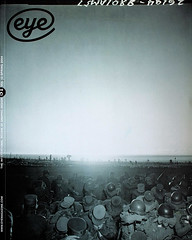Spring 2004
Alchemy of layout
Walter Pamminger champions the potential of design to create content
Composition dominates painting, photography, and cinematography as a primary means of structuring meaning. In graphic design, composition is often referred to as ‘layout’, but when it comes under scrutiny, it is typically in the form of analysing particular approaches to the grid. In texts on magazine and book design the grid is portrayed as an abstract structuring device, a tool capable of serving any number of potential contents. The grid is rarely invested with its own content, or granted a signifying function. Ultimately this is true to the spirit of the grid: it does not want to be particularised, it does not expect to be part of the signifying dimension. It is supposed to be the humble servant, invisible to the content that it serves.
This modesty of the grid is sometimes challenged by uses of it which seek to make it vocal, visible, and evident to the reader. Some of the most interesting examples of what I would call the ‘signifying grid’ have been realised in publications produced by Walter Pamminger. A chemist by training, Pamminger has a full time position as a researcher in the Austrian patent office. Graphic design and book collecting are his after-hours passions, and from his base-camp in Vienna’s first district, he follows the international graphic design field with a tenacity bordering on obsession. He is one of the most literate and thoughtful commentators on contemporary graphic design, a fact all the more surprising for his background in research and science. Yet in the German-speaking context science has never been segregated from the humanities. Pamminger and his colleagues move fluidly between science, philosophy, literature and science, and inhabit an unashamedly intellectual milieu.
In 1998 he organised an ambitious twelve-part lecture series, ‘Signs of Trouble’, with an international roster of graphic designers. The speakers he selected included Cornell Windlin, m/m, Anne Burdick, Jonathan Barnbrook, Mevis and van Deursen, 2x4, Tomato and myself, among others. He used this symposium to call the attention of the Viennese art and design communities to the vitality of graphic design in other parts of the world, and to underscore design’s potential contribution to publishing, commerce, and academia…
Abbott Miller, designer, Pentagram, New York
Read the full version in in Eye no. 51 vol. 13 2004
Eye is the world’s most beautiful and collectable graphic design journal, published quarterly for professional designers, students and anyone interested in critical, informed writing about graphic design and visual culture. It is available from all good design bookshops and online at the Eye shop, where you can buy subscriptions and single issues.

